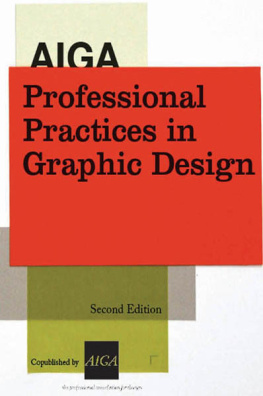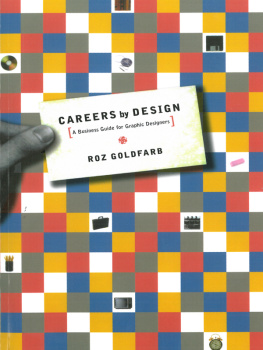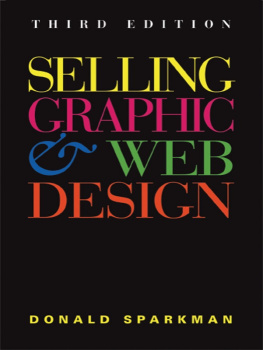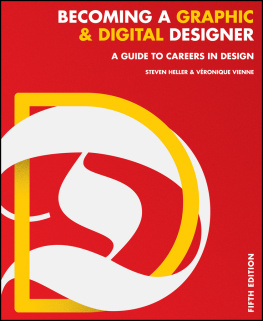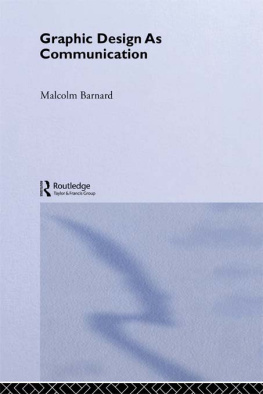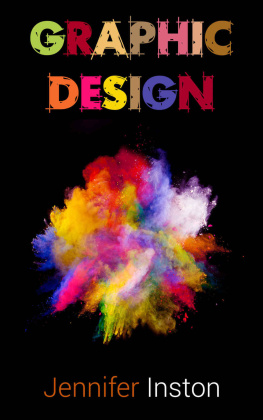

2008, 1998 AIGA
All rights reserved. Copyright under Berne Copyright Convention, Universal Copyright Convention, and Pan-American Copyright Convention. No part of this book may be reproduced, stored in a retrieval system, or transmitted in any form, or by any means, electronic, mechanical, photocopying, recording, or otherwise, without prior permission of the publisher.
12 11 10 09 08 5 4 3 2 1
Published by Allworth Press
An imprint of Allworth Communications, Inc.
10 East 23rd Street, New York, NY 10010
Cover design by James Victore
Interior design by The Roberts Group
Page composition/typography by Integra Software Services, Pvt., Ltd.,
Puducherry, India
Library of Congress Cataloging-in-Publication Data
AIGA professional practices in graphic design / edited by Tad Crawford.2nd ed.
p. cm.
Includes bibliographical references and index.
ISBN-13: 978-1-58115-509-9 (pbk.)
ISBN-10: 1-58115-509-3
eBook ISBN: 978-1-58115-749-9
1. Commercial artUnited StatesManagement. 2. Commercial artUnited StatesMarketing. I. Crawford, Tad, 1946- II. American Institute of Graphic Arts. III. Title: American Institute of Graphic Arts professional practices in graphic design. IV. Title: Professional practices in graphic design.
NC1001.6.A44 2008
741.6068dc22
2007047113
Printed in Canada
TABLE OF CONTENTS
Richard Gref |
Milton Glaser |
Richard Gref |
David C. Baker |
Maria Piscopo |
Ed Gold |
Eva Doman Bruck |
Jim Faris and Shel Perkins |
Don Brunsten |
Emily Ruth Cohen |
Cameron Foote |
Michael Jefferson |
Roz and Jessica Goldfarb |
Steve Liska |
Don Sparkman |
Don Carli |
Leonard D. DuBoff |
Shel Perkins |
Colin Forbes |
Peter L. Phillips |
Eva Doman Bruck |
Emily Ruth Cohen |
Daniel Abraham and Marci Barbey |
Ray and Scott Taylor |
Monona Rossol |
Tad Crawford |
Tad Crawford and Steven Heller |
Lee Wilson |
Don Brunsten |
Lee Wilson |
Leonard D. DuBoff |
Lee Wilson |
Allan Haley |
Organizations for Graphic Designers |
Emily Ruth Cohen |
AIGA Standards Richard Gref |
PREFACE
RICHARD GREF,
Executive Director, AIGA,
The Professional Association For Design
AIGA, the professional association for design, is dedicated to advancing designing as a professional craft, strategic tool, and vital cultural force. It is committed to leadership in the exchange of ideas and information, the encouragement of critical analysis and research, and the advancement of education and ethical practice.
This book is a comprehensive guide on professional practices for designers at all stages of their careers. The contents were developed in response to questions raised regularly by our membersworking professionals. The authors, in turn, have each worked regularly with practicing designers, so that their solutions to the challenges they address are based on both principle and pragmatism.
As a young profession, both in terms of the age of many practitioners and the history of the profession, it is important that designers begin to address challenges in their relationships with clients that develop a set of norms for professional practice. Only as designers reflect a consistent, responsive, and businesslike tenor in relations with their clients will an expected set of norms define an established ethos for the profession.
The practices described in this guide will help designers in managing their practiceswhether in a studio, agency, or corporate design department. They will also help to develop respect and trust for the designer in the business environment. Designers play an increasingly important role in creating value in a post-industrial society and information economy. AIGA and the advice contained here will help in assuring designers success as professionals, leaders, and a creative force.


| Short History
and the Longer View |
MILTON GLASER
So many legends, so little time. Ric Gref has asked me to speak briefly on the value of continuity in our profession. Of course one could take that charge to mean the short history of design, perhaps beginning with Peter Behrens, who is credited with the invention of identity programs and coordinating graphic and industrial design activities. Or one might consider our history as beginning with the first cave paintings at the dawn of history.
I prefer the longer view that relates our activity to the fundamental needs of the human speciesa species whose most distinctive characteristic is making things for a purpose, which turns out to be the actual description of what we do.
Any grandiosity or self-importance that this cosmic description of our activity creates in us will be quickly erased by the discovery that in a typical design class, only 30 percent of the students will have any idea who Paul Rand is and will not be able to identify Eric Nitsche or Lester Beall, let alone Joseph Hoffman, Edward Penfield, or Gustav Jensen. Incidentally, Jensen was a mentor to Paul Rand and, Cassandre aside, perhaps the designer he most admired, but I would not be at all surprised if most of us have never heard of himso much for understanding our own history.
I have always believed that there is a psychological and ethical difference between those who make things and those who control things. If form making is intrinsic to human beings and has a social benefit, then we can think of the good in good design having more than a stylistic meaning. Linking beauty and purpose can create a sense of communal agreement that helps diminish the sense of disorder and incoherence that life creates.
The part of design that is involved in fashion and marketing has the least need to examine and understand our history. Examining what has happened over twenty years seems to provide enough information to meet professional requirements, but, if our field aspires to be significant and worthy of respect, it must stand for something beyond salesmanship. Being a legend is an accomplishment that is hard won and sadly ephemeral, but being part of humankinds desire to make useful and beautiful things links us to a glorious history.
Next page
